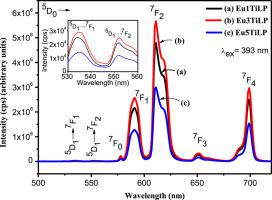Solid State Sciences ( IF 3.5 ) Pub Date : 2021-02-02 , DOI: 10.1016/j.solidstatesciences.2021.106560 Mithun De , Samar Jana , Subrata Mitra

|
A series of Eu3+ incorporated titanium lead phosphate glasses with the chemical compositions of 1 mol% Eu2O3+ xTiO2+(50–x)PbO+49P2O5 (where x = 1, 3 and 5) have been prepared by the melt quenching procedure. Structural investigations have been performed through XRD and FTIR spectra. Optical properties are investigated by absorption, excitation, photoluminescence emission, decay lifetime and CIE chromaticity measurements. Using absorption transition from 7F0 and 7F1 levels, the nephelauxetic ratio (β) and bonding parameter (δ) are estimated to determine the type of bonding between Eu3+ ions and the surrounding ligands. The absorption as well as the excitation spectra show that the band at 393 nm corresponding to 7F0 → 5L6 transition is very strong. Upon excitation at 393 nm, Eu3+ embedded titanium lead phosphate glasses exhibit maximum emission intensity for 5D0 → 7F2 transition at 611 nm which emits red color. Using Judd-Ofelt (JO) theory, the JO parameters Ω2, Ω4 and Ω6 have been estimated from the absorption and these parameters follow the trend of Ω2>Ω4>Ω6 for all glasses. These JO parameters are used to predict the branching ratio (βR), radiative transition probability (AR), stimulated emission cross-section (σPE) and radiative lifetime (τR). The larger value of spontaneous emission cross-section, suggests that the present glass samples are encouraging materials for Eu3+ embedded optical amplifiers and laser materials. Using the decay profile which shows single exponential, the luminescence decay lifetime of Eu3+ ions for the 5D0 metastable state is evaluated. The fluorescence quantum efficiencies have been evaluated which indicate that the values may be enhanced with the increase of titanium dioxide (TiO2) in the glass matrix. The color purity (CP) of the red emission and correlated color temperature (CCT) of these samples are calculated using the CIE (Commission Internationale de l’Eclairage) chromaticity diagram. Our investigation reveals that the present glasses may be utilized as red luminescent materials and red laser source for 5D0 → 7F2 emission at 611 nm.
中文翻译:

Eu 3+嵌入的钛酸铅磷酸盐玻璃的结构和光谱特性
一系列含Eu 3+的钛酸铅磷酸盐玻璃的化学成分为1 mol%Eu 2 O 3 + xTiO 2 +(50–x)PbO + 49P 2 O 5(其中x = 1、3和5)。通过熔融淬火程序制备。通过XRD和FTIR光谱进行了结构研究。通过吸收,激发,光致发光发射,衰减寿命和CIE色度测量来研究光学性质。使用7 F 0和7 F 1的吸收跃迁估计水平,肾上腺皮质激素比率(β)和键合参数(δ),以确定Eu 3+离子与周围配体之间键合的类型。吸收光谱和激发光谱表明,在393 nm处对应于7 F 0 → 5 L 6跃迁的谱带非常强。在393 nm激发时,嵌入Eu 3+的钛酸铅钛玻璃在611 nm处出现5 D 0 → 7 F 2跃迁的最大发射强度,并发出红色。使用贾德-Ofelt理论(JO)理论,JO参数Ω 2,Ω 4和Ω 6从吸收已被估计,并且这些参数遵循Ω的趋势2 >Ω 4 >Ω 6为所有的眼镜。这些参数JO用于预测的分支比(β - [R ),辐射跃迁概率(A - [R ),受激发射横截面(σ P ë)和辐射寿命(τ - [R )。自发发射截面的较大值表明,当前的玻璃样品是用于Eu 3+嵌入式光放大器和激光材料的令人鼓舞的材料。使用显示单指数的衰减曲线,Eu 3+离子在5 D时的发光衰减寿命评估为0亚稳态。已经评估了荧光量子效率,其表明该值可以随着玻璃基质中二氧化钛(TiO 2)的增加而提高。使用CIE(国际照明委员会)色度图计算这些样品的红色发射的色纯度(CP)和相关色温(CCT)。我们的研究表明,本玻璃可用作红色发光材料和红色激光源,用于在611 nm处发射5 D 0 → 7 F 2。


























 京公网安备 11010802027423号
京公网安备 11010802027423号